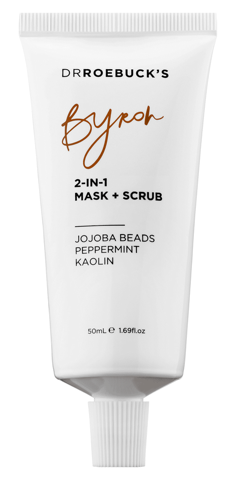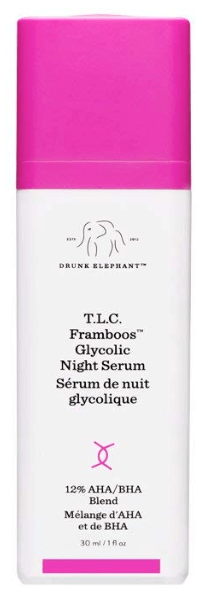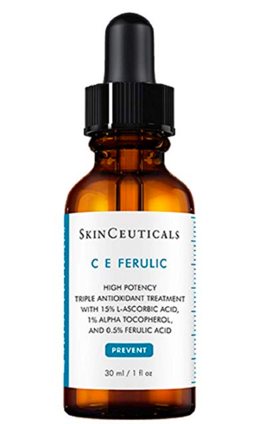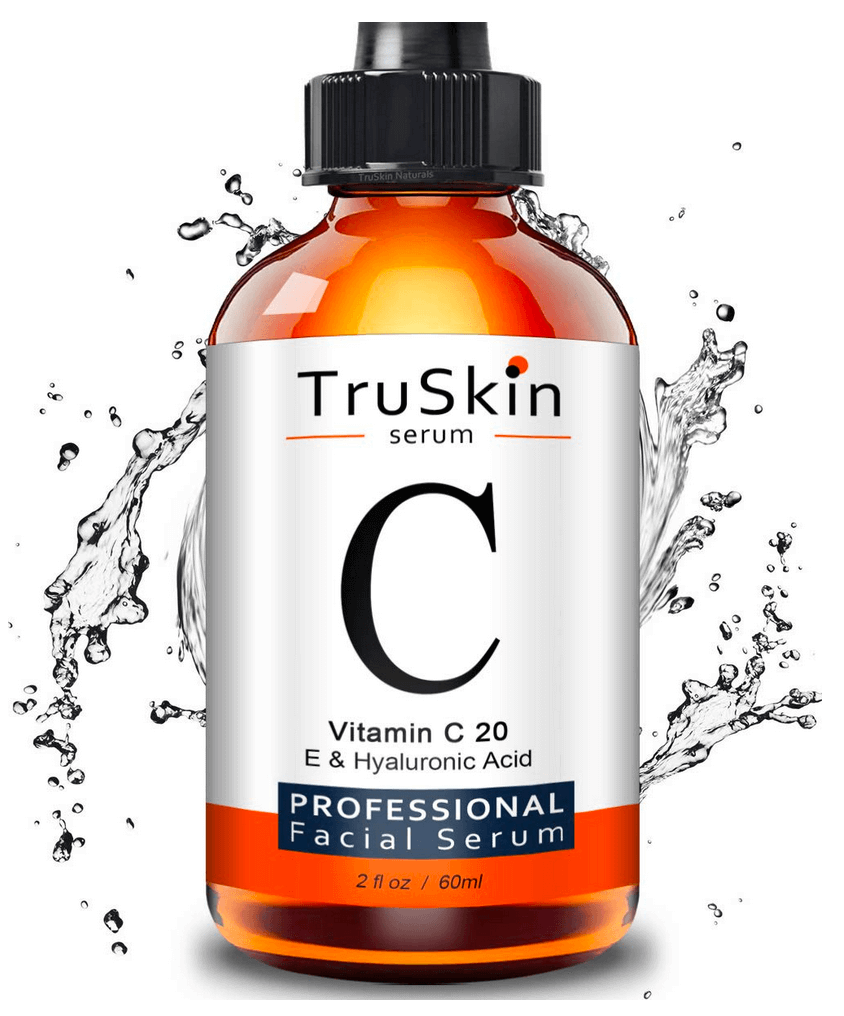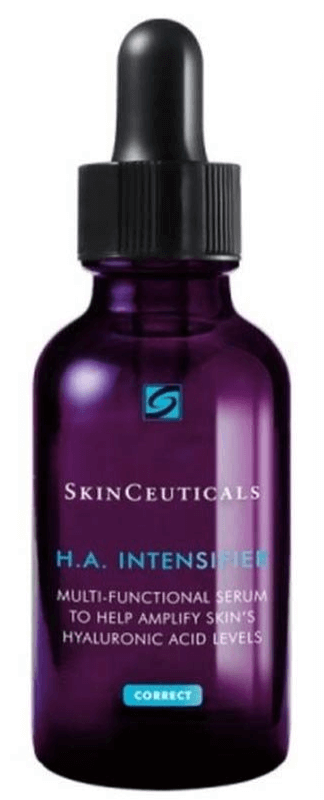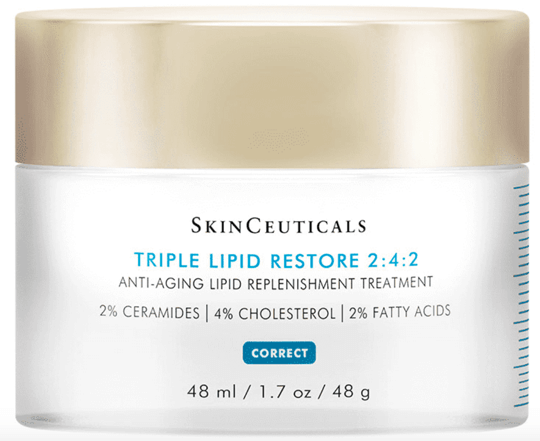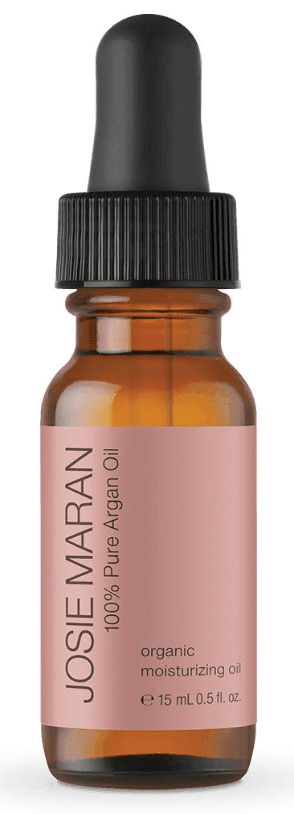Fine Lines & Wrinkles:
Causes, Treatments, & Top Ingredients
GHS ONE-LINER: Little crinkles that come with age
Fine lines and wrinkles are lines or indents on the skin associated with aging. Skin wrinkling, also known as rhytids, and skin sagging, also known as elastosis, are results of damage to proteins in the deeper layers of your skin. The main proteins that get damaged are collagen (a protein that keeps skin firm) and elastin (a protein that keep skin flexible, bouncy, and elastic). Even though fine lines and wrinkles develop from within the deeper layers of your skin, topical treatments can work to soften fine lines and wrinkles from the outside in.
What Causes Fine Lines and Wrinkles?
Keep in mind: aging is a biological inevitable process influenced by a combination of intrinsic (naturally occurring) and extrinsic (external) factors. Intrinsic aging is a physiological process that results in thin, dry skin, and fine lines and wrinkles, while extrinsic aging is caused by external environment factors such as sun exposure, air pollution, smoking, and poor nutrition, also resulting in fine lines and wrinkles, loss of elasticity, and rough-textured skin.
Repeated Facial Expressions
All facial expressions you repeat over time will eventually lead to fine lines and wrinkles (squinting, smoking, smiling, laughing, frowning, crying, etc.). In younger skin, these creases appear temporarily when you make expressions, but the elastin in your skin is stronger and bounces back to its original shape. As you age, however, your skin loses its elasticity, the fibers in those areas weaken overtime from the constant bending and moving of your facial muscles in the same places. This, combined with subcutaneous fat loss (fat loss under all the layers of the skin), results in looser, sagging skin, causing facial expression fine lines and wrinkles.

Sun Damage & Free Radicals
According to the skin cancer foundation, 90% of aging and wrinkles is caused by cumulative sun damage. Cumulative sun damage is not only direct sun exposure outside, but also repeated UVA exposure through glass windows (like driving or sitting at a desk by the window). UV rays cause sun damage by inflaming the skin, and this inflammation morphs some skin cells into free radicals. These new free radicals go on to break down your collagen and elastin fibers -- collagen and elastin are two of the most important proteins in your skin when it comes to anti-aging because they provide skin strength and elasticity, and damage to collagen and elastin fibers is ultimately what leads to the development of fine lines and wrinkles.
Damaged collagen and elastin fibers combined with the dehydration caused buy sun exposure can lead to permanent elastic creases (criss-cross wrinkles), atrophic crinkling rhytids (parallel fine lines that can appear anywhere on your face or body and change in shape/orientation with your body posture), and skin sagging. In severe cases, sun damage can cause skin cancer.

Dry & Dehydrated Skin
Dry and dehydrated skin accelerates the development of fine lines and wrinkles in many ways. First, dry, dehydrated skin is more prone to inflammation, and inflammation is linked to the development of fine lines and wrinkles. Second, dry skin most likely means there are gaps in the epidermal lipid layer -- the natural fat layer that provides a barrier to keep moisture in your skin and environmental damages out. Gaps in between your epidermal lipids allow water and electrolytes to escape, and this type of water loss makes your skin more susceptible to fine lines and wrinkles from repeated facial movements. On top of that, our lipids do not reproduce as quickly as we age (because our skin cells do not renew as quickly) which contributes to increased hydration loss and the development of wrinkles overtime time. Just remember, moist skin is juicy-bouncy, and dry skin is shrively-wrinkly.

Loss of Collagen with Age
Collagen is a protein that is naturally found in your body and it makes up 70-80% of the protein within our skin. Collagen is essential for skin strength, elasticity, and bounce -- in other words, it keeps your skin from forming wrinkles and sagging. Unfortunately, as we age, our body begins to produce less collagen. After the age of 20, the dermis layer produces 1% less collagen each year, and less collagen means less youthful looking skin. As a result, overtime we develop permanent elastic creases (criss-cross wrinkles), atrophic crinkling rhytids (parallel fine lines that can appear anywhere on your face or body and change in shape/orientation with your body posture) and gravitational folds (nasolabial folds, drooping of your upper eyelids, and marionette lines).

Smoking
When you smoke, you repeatedly pucker or “purse” your lips. Not only do you engage in a repetitive movement that deepens the creases around your mouth, but also you constantly exposure your skin to harmful chemicals that can cause free radical damage. As a result, smoking regularly will eventually lead to fine lines and wrinkles around your mouth in the forms of dynamic expression wrinkles and gravitational folds.

Gravity
Gravity alone can't cause fine lines and wrinkles; however, gravity helps accelerate age-related thinning and sagging. There's even a specific term for these types of fine lines and wrinkles: gravitational folds (nasolabial folds, drooping of your upper eyelids, and marionette lines). Who's ready to live on the moon?

Sleeping Habits
Sleeping on your face (the side or face down) can cause compression fine lines and wrinkles. Yes, this is actually a thing. Don't squish your face on your pillow. You're way more empowered than Snow White and Sleeping Beauty, but if there's one lesson we can take from these ladies, try to sleep on your back without putting pressure on your face.

Hormonal Aging & Menopause
Collagen production requires estrogen, and as you age your hormones change, especially during menopause. During menopause, your estrogen levels will dramatically drop causing your skin cell renewal to slow down. This unfortunately can lead to uneven skin tone, dullness, and faster development of fine lines and wrinkles: specifically, atrophic crinkling rhytids (parallel fine lines that can appear anywhere on your face or body and change in shape/orientation with your body posture) and gravitational folds (nasolabial folds, drooping of your upper eyelids, and marionette lines). The good news is, the more preventative measures you take prior to menopause, the better shape your collagen and elastin fibers will be in when the time comes.

Types of Fine Lines and Wrinkles
Deeper wrinkles like forehead lines, frown lines (“scowl” lines between your eyes also known as “the 11s”), crow’s feet around your eyes, smile lines, smoking lines, neck lines (from looking down at your phone).
Caused by: repeated facial expressions, loss of elastin and collagen, or smoking
Nasolabial folds (deep wrinkles or lines that form from the bottom of the nose to the corners of the mouth), drooping of your upper eyelids, and marionette lines (run vertically on either side of your chin).
Caused by: gravity, loss of elastin and collagen, hormonal aging & menopause, or smoking
Criss-cross wrinkles that usually run parallel to each other and exist on your cheeks, around your lips, and on your neck or chest.
Caused by: cumulative sun damage & free radicals or hormonal aging & menopause
Fine lines that can appear anywhere on your face and body, and are almost always parallel to each other - they change in shape and orientation with body posture or when skin is stretched transversely.
Caused by: cumulative sun damage & free radicals, loss of collagen with age, or hormonal aging & menopause
How to Prevent Fine Lines & Wrinkles

Use a Physical Exfoliant Weekly
Exfoliate with a light physical exfoliant scrub weekly to remove dead, surface skin cells. Exfoliating dead skin cells promotes cell regeneration, and when skin cells regenerate, collagen (what makes skin tight, elastic, and bouncy) and lipids (our natural defense against moisture loss) also renew and regenerate. Healthy collagen and lipids are two of the most important things to prevent fine lines and wrinkles.

Invest in AHAs and Retinoids
AHAs (alpha hydroxy acids) and retinoids work to exfoliate and dissolve dead, surface skin cells. Similar to a physical scrub, AHAs and retinoids accelerate skin cell renewal which means faster renewal of collagen and lipids, but AHAs and retinoids are much stronger than physical scrubs. AHAs and retinoids have the powerful ability to remove deeper layers of dead skin, evening out your skin's surface which actually reduces the depth of fine lines and wrinkles. The result? Fine lines and wrinkles appear faded and less pronounced. In fact, existing small fine lines and wrinkles can actually be completely faded with consistent and proper use (faded as in you won't see them as clearly, but the underlying creases may still be there...sadly, nothing can be 100% erased once it develops). One thing to note is AHAs and retinoids can cause skin irritation - this is totally normal. Start by conditioning your skin with a patch test on the inside of your forearm and then with small amounts on your face. Use once or twice a week working your way up to every other day or daily use. Also, never use a physical scrub or any type of mechanical exfoliation the same day as an AHA or retinoid.

Antioxidants = Anti-Wrinkle
Inflammation sucks because it's directly correlated to both the development and intensification of fine lines and wrinkles... And antioxidants rule because they fight inflammation. Inflammation leading to fine lines and wrinkles is caused by free radical damage as a result of sun damage and environmental toxins. UV rays specifically cause inflammation by way of generating free radicals that then harm existing skin cells by stealing electrons and this alters the skin cells existing molecular makeup. Over time, this damage visually results in fine lines and deeper wrinkles and in some cases, can lead to skin cancer. Antioxidants reduce inflammation by scavenging for free radicals. Basically, it's a constant war on your face. Support antioxidants and kick free radical ass by applying a serum daily (morning and night). Great antioxidant choices include vitamin C (ascorbic acid), vitamin E (tocopherol), green tea extract, grape-seed extract, retinoids, and alpha lipoic acid (ALA).

Hydrate with Humectants Daily
Hydrating your skin is absolutely critical to preventing fine lines and wrinkles. If your skin is dry and dehydrated, it will wrinkle faster and deeper. Period. So first, replenish hydration to your skin twice a day with products containing hydrators or humectants like hyaluronic acid or glycerin. Serums contain the highest concentrations of hydrating ingredients and may be the most critical step to restoring and reviving moisture in your skin.

Seal in Moisture with Emulsions, Lotions, Creams, or Oils Daily
COMBINED HYDRATORS & MOISTURIZERS
After hydrating with humectants, seal in that moisture and reinforce your lipid barrier (your skin's natural defense against water loss) with moisturizers - emulsions, lotions, and creams - that contain glycolipids, ceramides, fatty acids, and cholesterol; OR with oils like argan oil or rosehip oil. Think of this step like setting spray on top of your makeup--both keep everything in place and make everything last longer. To properly hydrate your skin, you need both hydrators and moisturizers (in that order). Otherwise you'll be doing half the work for negative results. Emulsions, lotions, and creams are products that reinforce the hydrating benefits of your essence and serum(s). Because these products normally combine hydrating and moisturizing ingredients, they both restore new hydration to the skin as well as lock in the moisture just applied by the essence and serum. If you're applying more than one, just remember to apply in the order of more hydrating to more moisturizing, so emulsions first, lotions next, followed by creams, and oils last.

Wear Sunscreen Every Day!
Just do it. Sun damage directly correlates to the development and intensification of fine lines and wrinkles. Simple as that. Sun damage is so damaging because UV rays penetrate the skin, wiggle things around (in the worst way) , and turn healthy skin cells into free radicals, which then go on to destroy other healthy skin cells. There are two types of UV rays that damage the skin—UVB and UVA rays. UVB rays are shorter and cause sunburns. UVA rays are longer and more dangerous because they penetrate deeper layers of skin causing DNA damage and at worst, skin cancer. Besides the fact that chronic sun damage will cosmetically result in deeper fine lines and wrinkles, it can be dangerous af. Protect yo’skin people! Even if it’s overcast, wear sunscreen. Apply as the final step of your morning skin care routine before makeup.

Healthy Habits: Diet, Exercise, & Sleep
Your skin reflects your overall health. So if you have unhealthy habits—as in, you consistently eat like garbage, don’t drink enough water, don’t exercise enough, or don’t sleep enough—you'll see the negative consequences in your skin, one of them being premature aging. Your skin doesn't lie. Smoking and extreme stress will also lead to early development of fine lines and wrinkles. An easy way to get started is to drink plenty of water daily (recommended 8 glasses) and eat antioxidant-rich foods like blueberries, strawberries, raspberries, goji berries, kale, spinach, red cabbage, artichokes, almonds, pecans, and walnuts to name a few (there are many more to choose from!). Be good to yourself inside and out, and your skin will glow.

Be Consistent with Your Skin Care
Consistency is key. We can’t emphasize this enough. All skin care products and ingredients that target fine lines and wrinkles do not work overnight, so find what works for you, and stick with it. Certain ingredients can take up to 8 weeks of consistent use before you'll see noticeable results. Be patient, and maintain your morning and night skin care routines for optimum results. Investing in yourself is always worth it.
Check out the GHS 10 Best Products for Preventing Fine Lines & Wrinkles.
Our curated list is paraben-free, sulfate-free, and phthalate-free.
Top 6 Ingredients for Fine Lines & Wrinkles
✓ AHAs
- Exfoliates dead skin cells
- Accelerates cell turnover rate
- Brightens complexion
- Reduces the appearance of wrinkles
Popular AHAs: lactic acid, glycolic acid, or citric acid
✓ Retinoids
- Exfoliates dead skin cells
- Accelerates cell turnover rate
- Brightens complexion
- Stimulates the production of collagen and elastin
Popular Retinoids: retin-A (tretinoin), retinol, or retinaldehyde
✓ Antioxidants
- Fights free radical damage
- Strengthens your skin’s barrier
- Stimulates collagen production
Popular Antioxidants: vitamin C, vitamin E, nicotinamide (vitamin B3), coenzyme Q10, or green tea
✓ Peptides
- Stimulates the production of collagen and elastin
- Protects collagen in your skin
Popular Peptides: matrixyl; palmitoyl oligopeptides, tripeptides, tetrapeptides, hexapeptides, or pentapeptides
✓ Humectants
- Moisturizes and hydrates
- Strengthens your skin’s barrier
- Reduces the appearance of wrinkles
Popular Humectants: hyaluronic acid, glycerin
✓ Lipids
- Locks in moisture within your skin
- Strengthens your skin’s barrier
- Protects your skin from damage
Popular Lipids: ceramides, natural cholesterol, and fatty acids
FAQs about Fine Lines & Wrinkles
Q. What causes fine lines and wrinkles?
- Repeated facial expressions
- Sun damage and free radicals
- Dry and dehydrated skin
- Loss of collagen with age
- Gravity
- Smoking
- Sleeping habits
- Hormonal aging and menopause

Q. How do you prevent fine lines and wrinkles?
- Use a physical or chemical exfoliant weekly
- Invest in AHAs (alpha hydroxy acids) and retinoids
- Fight free radicals with vitamin C (ascorbic acid) and vitamin E (tocopherol) serums daily
- Hydrate with humectants (i.e. hyaluronic acid) daily
- Seal in moisture with emulsions, lotions, creams, or oils daily
- Wear sunscreen every day
- Healthy habits: diet, exercise, and sleep
- Be consistent with your skin care - all skin care products and ingredients that target fine lines and wrinkles do not work overnight

Q. Are wrinkles reversible? Can wrinkles be reversed?
No. Unfortunately, science has yet to discover a single ingredient that can permanently reverse the aging process. Topical and professional treatments can temporarily minimize the appearance of wrinkles, but they cannot make them completely disappear. This is why it’s very important to adopt an anti-aging skin care routine at an early age in order to prevent an accelerated aging process.

Q. At what age do wrinkles start appearing?
It is very common for fine lines and wrinkles to start appearing in your late 20s. This is when your skin begins to become more dry, opening you up to fine lines around the eyes and mouth. We HIGHLY recommend starting your anti-aging skin care routine in your early 20s to protect your skin and fight against future daily damage that causes fine lines and wrinkles overtime.

Q. Why does skin start to sag as we age?
Elastin fibers are the mini rubber bands that keep skin tight to the body. As we age, the elastin fibers stretch out and start to lose snappiness from repeated facial movements and gravity weighing the skin down. Sun damage can also damage the elastin fibers causing saggy skin.

Q. Does dry skin age faster than oily skin?
There is no straight answer to this question. Oily skin can appear more youthful than dry skin because oily skin is usually thicker than dry skin, but thicker skin can develop deeper looking facial expression wrinkles. On the other hand, oily skin has more protection against dehydration than dry skin, and dehydrated skin is more prone to inflammation which can trigger/accelerate fine line and wrinkle development. Dry skin also emphasizes the appearance of existing fine lines and wrinkles compared to hydrated skin. But to level the playing field, both dry skin and oily skin are equally subject to sun damage. No matter what your skin type, the key to healthy skin is to develop the right skin care routine that works for you and your concerns.

Q. Does dry skin cause fine lines and wrinkles?
Dry skin does not cause fine lines and wrinkles but dry, dehydrated skin does tend to develop fine lines and wrinkles earlier than healthy, hydrated skin. This is true for a number of reasons. When your skin is dry, facial expressions are harsher on your skin's elastic fibers and your elastin fibers crease easier rather than bouncing back into place. Dehydrated skin is also more prone to inflammation, and inflammation is linked to the development and intensification of fine lines and wrinkles. Finally, other anti-aging products, treatments, and serums won’t work as well if your skin is dry. In some scenarios, certain products will be too harsh and will actually do more damage than good if your skin isn't properly hydrated. For these reasons, properly hydrating your skin twice a day is essential to preventing fine lines and wrinkles. And that goes for everyone! Even oily skin types.

Q. What can I do for my wrinkles around my mouth?
Wrinkles around the mouth (officially known as perioral rhytids and sometimes called "smoker's lines") form from repeated facial expressions like smiling, frowning, and pursing of the lips (don't take too many duckface selfies). Like treating all other types of facial wrinkles, a skin care regimen with antioxidants, AHAs, peptides, and lipids can help soften around the mouth wrinkles, but this particular area can be harder to treat (we express ourselves a lot with our mouths). There are filler injection options (common filler is Restylane), but to be honest, fillers are temporary fixes and the mouth wrinkles can come back after the procedure. We recommend caring for this area with a consistent skin care routine that will also benefit other fine line/wrinkle areas on your face.

Q. Can facial exercises help soften fine lines and wrinkles?
Technically, yes, but realistically, no. It's hard to isolate the exact facial muscles that need tightening and strengthening without also making the facial expressions that deepen existing expression lines and wrinkles. Micro-current treatments can target facial muscles that need "working out" and can lift the face without activating facial muscles that cause expression wrinkles. We recommend a consistent skin care routine above all else to care for your fine lines and wrinkles.

Q. What wrinkles does Botox work on?
Botox is a commonly used injection that works best on dynamic expression wrinkles because it temporarily paralyzes your facial muscles. Post Botox, the facial muscles you chose to target will not be able to move or contract, resulting in softening of existing fine lines and wrinkles caused by repeated facial expressions and prevention of further deepening of fine lines and wrinkles.

Q. How do I know if I need a chemical peel?
Chemical peels should only be done if fine lines and wrinkles or hyperpigmentation are moderate to severe. Consult your esthetician, dermatologist, or plastic surgeon on in home products to use before jumping to chemical peels.

Q. What is the best antioxidant to use to fight free radical skin damage?
There isn't one antioxidant that reigns supreme because there are many types of free radicals. The short answer is a mixture of different types of antioxidants is the best way to treat free radical damage. To dive a little deeper, when a free radical steals an electron from another cell, the cell that has been robbed now wants a replacement electron and has turned into a free radical itself. The catch is the new free radical may not necessarily be the exact same type of free radical that robbed it in the first place. For example, a free radical oxygen could steal from a lipid cell, and the oxygen cell is now satisfied with it's stolen electron, but now the lipid cell has turned into a free radical that wants to steal an electron from another atom. Because of the variety of types of free radicals and their chain reactions, having a diverse mixture of antioxidants is your best bet.

Q. How do you know if an antioxidant product has expired or gone bad?
You don't want to use any antioxidants if the product has already oxidized in the package. There will be no skin care benefit. If the product starts looking darker or turns brown, it has gone bad. Store your antioxidants in cool, dark places (no direct sunlight) to prolong the shelf-life. Often times, antioxidants will be formulated into serums with other ingredients to help prevent premature oxidation.

Q. What should I look for in an AHA product? How do I choose an AHA product?
There are many AHA products on the market, but here are a few guidelines:
- If you have dry skin, go for an AHA cream or lotion.
- If you have oily skin, go for an AHA gel.
- AHA serums can be used on all skin types.
- There are AHA cleansers and scrubs, but AHA products that you rinse off are not as effective as products that absorb into the skin.
- Use a product with 8-10% AHA concentration (it can be a combination of multiple types of alpha hydroxy acids). Anything over 10% can cause aggressive peeling, but if you want to go stronger than 10%, consult your dermatologist first and possibly think about a peel procedure as another option.
- Use a product with a pH level around 3.5. Anything more acidic (lower pH) may be too strong and can cause unwanted inflammation.
- When using ANY type of AHA product, wear sunscreen. The fresh skin the AHAs expose is weaker and more prone to UV damage. We cannot hammer on this enough!

Q. Can I mix alpha hydroxy acids, antioxidants, lipid products, peptides, moisturizers, and sunscreens?
Yes! We recommend using a combination of all ingredient types to best address existing fine lines and wrinkles. They all work in different ways to treat the same problem. You don't have to use all products at the same time. For example, you could use peptides and antioxidants morning and night, but only use AHAs at night. Whatever routine you craft, remember it's best to attack the fine lines and wrinkles from all angles!

Want More GHS Tips?
It’ll be the best thing to ever slide into your DM's.
